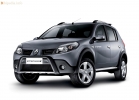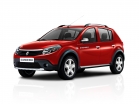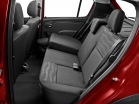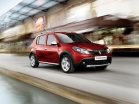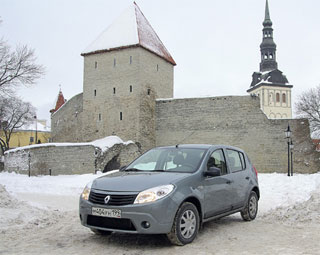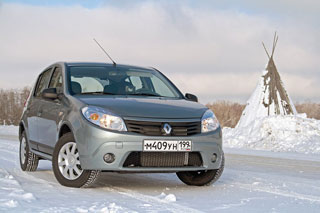Renault Sandero STEPWAY test drive since 2010 hatchback
Six months with Renault Sandero: Snow and Frost
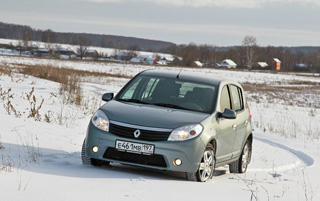 Renault Sandero 1.6 Prestige automatic transmission
Renault Sandero 1.6 Prestige automatic transmission Total mileage 9,600 km
Mileage from the moment the dough starts 8,287 km
A month and a half ago, winter entered its legal rights, our Renault Sandero received the appropriate shoe and began to iron the Moscow streets flooded with a reagent. Of course, the hatchback properly woke up in the morning, quickly heated the salon and, in general, did not cause much complaints of frosts. And finally, the thermometers arrows began to fall below 20O C. Has anything changed?
There are still no problems with cold starting even after several days of Sandero's parking is easily started. Coolish speeds do not swim, the engine works evenly. Moreover, regardless of the used fuel of gasoline with an octane number of 92 or 95. Although the owners faced the unstable operation of the engine on the old 8-valve on the 92nd during cold start. The dealers recommended using the 95th, but still surrendered under the onslaught and changed the firmware of the control unit, which most often removed the question.
Even on idle, the engine warms up quickly enough only a few minutes before the column of the coolant temperature indicator on the modest liquid crystal screen begins to fill. On the go, of course, will go faster, but first you should do windows.
The efficiency of the heater is reduced by the non -optimal distribution of air flows, for example, into severe cold, even if the maximum of hot air is put down, the legs are still freezing for the first time. There and the banter. With laterals, full order (deflectors can be directed to them), but blowing the lobe is not wide enough, the central part is first warmed up. However, if there is no time to wait, you can always use an aerosol anti -recovery or a thawed thast based on alcohols.
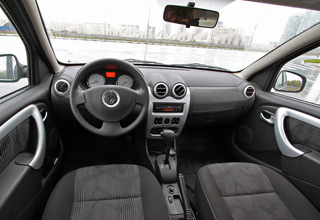
It is bad that there is no salon filter (it is not included in the package of even the most expensive Sandero). In the summer, dust regularly flew into the salon, and now, after parking, even ... snow can get inside. However, dealers for an additional fee put a filter in Logan/Sandero. In addition, the environmental situation on the roads worsens strongly in calm and frosty weather. As a result, in traffic jams, you regularly breathe exhaust gases from unheated engines. Recirculation? Yes, it removes the problem, but then condensate is formed on the glasses. Partly from this murderer can help the replaced element of the filter with activated coal.
But the heating of the seats is effective, although it does not have an intensity adjustment, and its buttons are hidden in a blind area based on the chair. The back of the wiper can boast of a huge cleaning area! Only first you need to wait until it thaws, and this process is not unbearable. Electric heating of the lateral mirrors turns on simultaneously with the threads of the rear window.

But the front wiper does not withstand criticism. The brushes due to the small length and non-optimal geometry of the trapping of the drive rods leave large uncleaned areas in the area of \u200b\u200bthe driver’s rack and the upper right corner from the passenger side. From the triangle in the center, where the salon mirror, on the cleaned glass in wet and snowy weather, is constantly flowing down the famous Loganovskaya tear that has already become a parable in the tongue.
It is also formed in frosts from non -freezing liquid. But most of all it is surprising that the wipers do not turn on independently if you use the glass gunner. What did you save on? On a penny roof? A strange thing, because the back brush with the washer is turned on at the same time, however, here, on the contrary, there is no intermittent mode, the rear janitor can only clean the constant.
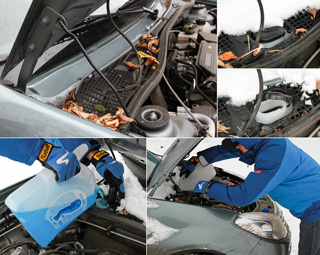
The washer tank is not the most voluminous, only three liters, in sliding weather, add washing more often than usual. And to do this is inconvenient, the narrow neck is located at the motor shield at a solid distance from the right side of the car. While you reach it and cope with the obstinate lid (you always need to hold it), you can stain your clothes.
There are complaints about aerodynamics. More precisely, to the distribution of dirt on the body. I am glad that even in very sloping weather, the headlights and rear lights Sandero are not so dirty as, for example, in Hyundai Solaris, and the mirrors resist the nasty brown film for a long time. But what if the side glasses are instantly sprayed in snotty conditions? 20 minutes of movement in the puddles of the reagent and you can safely stop to wipe the window. Although there is a direct dependence on the speed of movement the more slowly, the cleaner.
The main part of moisture and dirt flying from under the front wheels is besieged on the sidewalls to the waist line. The lower part of the stern attracts the mud most, and there is a castle of the fifth door. Open the trunk and not to stain your hand almost an unrealistic task. By the way, after washing in frosty weather, you should definitely click on the lock button with a larva several times and open/slam the door differently will freeze.
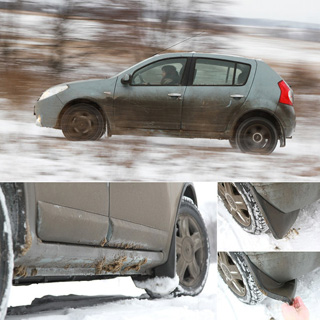
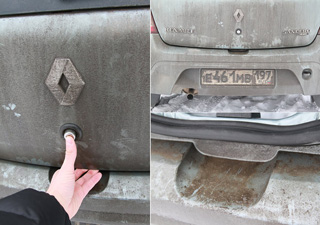
But these are trifles and nuances. It is much more important that Renault Sandero is perfectly adapted to winter roads. Did the communal workers leave the snow parapet along the parked cars? No problem! Sandero will jump on the first attempt! Large road clearance and good parameters of geometric patency (which we have already seen, having traveled along slippery slopes), plus a small mass help on snow virgin lands.
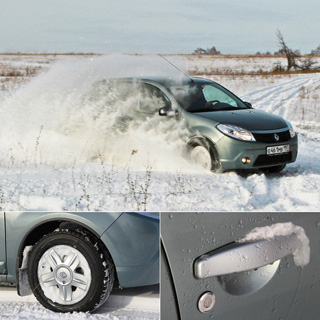
10-20-centimeter snow for a car Sando is not a hindrance. The main thing is that the tires are appropriate. On the editorial car there is an unsolved Yokohama Ice Guard IG30. On the asphalt and ice is not the best option, but in snowdrifts rubber drags well
Note that Logan can boast of similar abilities (we tested it 2 years ago and just got into snowfalls). The curious fact that Logan was then, that Sandero was now shod in mediocre, non -navigated Yokohama Ice Guard (IG20 in Logan and IG30 at SANDERO). What will happen on a good spike?
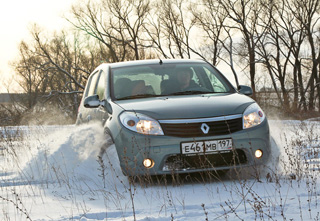
If you are planning an off -road landing or driving on highly noticeable roads, it is better to choose a mechanical version. Large mechanical and thermal loads of the hydrotransformer automatic machine experiences worse than simple mechanics. In addition, get out of the trap, rocking the car back and forth, with a manual box it is always easier, moreover, for the latter it is less painful
And why such a choice? The trick is disclosed. Soft, non -navigated tires not only slightly improve the smoothness of the move (with this, however, Sandero is already fine), but they have a beneficial effect on acoustic comfort. On the Winter Yokohama Sandero became even a little quieter than on the standard summer tires of Barum Brilliantis!
And, gratifying, the tires did not spoil the controllability of Sandero. On winter roads with slippery mixed coatings, Sandero surprises the steering settings transparently. The condition of the coating on the steering wheel is felt both under gas and when pressed on the brake. It is worth the asphalt to change to ice or unscrewed snow, returning the feedback force on the steering wheel drops adequately to the frictional properties of the coating. Say: Caution! Slippery! There is nothing to cling to!. Thanks to the hydraulic storage. The striking contrast, for example, with our Citroen C4, where the steering wheel after a re-fraud lost any information about the road at all.
But what about fuel consumption? Automatic box, winter tires and frosts force to spend 11.3-11.7 liters of fuel per 100 kilometers in the city cycle. A bit a lot by modern standards. The machine, by the way, also works softer than on Citroen, even in the first minutes after cold start. The point is in the brains? But structurally modernized boxes DP2 and AL4 are practically identical, therefore, like C4, the unit is sometimes confused in the programs.
But on the highway, Sandero spends 7.3-7.7 liters per hundred kilometers, but with one reservation: it is better to keep the speed within 90-110 km/h. If you go faster, a large cross -sectional area and non -optimal body aerodynamics affects the consumption. However, if you choose the 95th instead of the 92nd, then the consumption will fall on an average of 0.5 l/100 km.
Very soon, our Sandero will overcome the line of 10,000 kilometers. So far, the car has not delivered us trouble. The interval interval is 15,000 km, but we won’t wait for this run, we will drive the car earlier for the audit. At a minimum, you need to see in what condition the chassis is located. But first we compare Renault Sandero with its main enemy Korean hatchback Hyundai Solaris. What's better? Learn in 2 weeks!
Vitaly Kabyshev, Vadim Gagarin
Photo: Vitaly Kabyshev
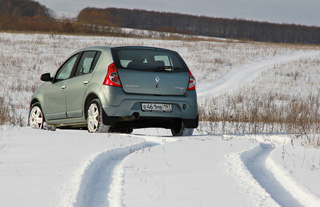
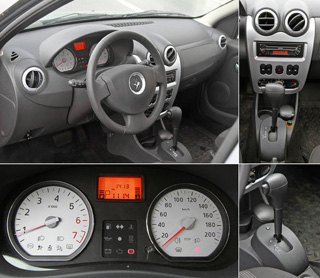
Specifications
Body
Type of hatchback
Engine
Working volume, cm 1598
Power, L.S. at rpm 102 at 5750
Torque, NM at rpm 145 at 3750
Dimensions, mass, volumes
Length, mm 4020
Width, mm 1746
Height, mm 1534
Wheel base, mm 2588
Clearance, mm 155
Equipped mass, kg 1090
Dynamic characteristics
Acceleration from a place to 100 km/h, from 11.7
Maximum speed, km/h 175
Fuel consumption
Average conditional fuel consumption, l/100 km 8.4
City, l/100 km 11.8
Highway, l/100 km 6.7
Source: Auto.mail.ru


